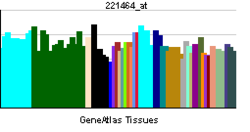OR1D2
Izgled
| edit |
| Olfaktorni receptor, familija 1, potfamilija D, član 2 | |||||||||||
|---|---|---|---|---|---|---|---|---|---|---|---|
| Identifikatori | |||||||||||
| Simboli | OR1D2; OLFR1; OR17-4 | ||||||||||
| Vanjski ID | OMIM: 164342 MGI: 3030246 HomoloGene: 37634 GeneCards: OR1D2 Gene | ||||||||||
| |||||||||||
| Pregled RNK izražavanja | |||||||||||
 | |||||||||||
| podaci | |||||||||||
| Ortolozi | |||||||||||
| Vrsta | Čovek | Miš | |||||||||
| Entrez | 4991 | 258153 | |||||||||
| Ensembl | ENSG00000184166 | ENSMUSG00000058275 | |||||||||
| UniProt | P34982 | Q7TRW7 | |||||||||
| RefSeq (mRNA) | NM_002548.2 | NM_001011851.1 | |||||||||
| RefSeq (protein) | NP_002539.2 | NP_001011851.1 | |||||||||
| Lokacija (UCSC) | Chr 17: 3 - 3 Mb | Chr 11: 74.36 - 74.37 Mb | |||||||||
| PubMed pretraga | [1] | [2] | |||||||||
Olfaktorni receptor 1D1 je protein koji je kod ljudi kodiran OR1D1 genom.[1][2][3]
Olfaktorni receptori formiraju interakcije sa molekulima mirisa u nosu, čime se inicira neuronski respons koji izaziva percepciju mirisa. Oni su odgovorni za prepoznavanje i G proteinima posredovanu transdukciju mirisnih signala. Proteini olfaktornih receptora su članovi velike familije G protein spregnutih receptora (GPCR). Poput mnogih receptora za neurotransmitere i hormone, olfaktorni receptori imaju strukturu 7-transmembranskog domena. Oni su kodirani genima sa jednim eksonom. Geni olfaktornih receptora su najveća familija genoma. Nomenklatura gena i proteina olfaktornih receptora je nezavisna od drugih organizama.[3]
- ↑ Parmentier M, Libert F, Schurmans S, Schiffmann S, Lefort A, Eggerickx D, Ledent C, Mollereau C, Gerard C, Perret J, et al. (Mar 1992). „Expression of members of the putative olfactory receptor gene family in mammalian germ cells”. Nature 355 (6359): 453–5. DOI:10.1038/355453a0. PMID 1370859.
- ↑ Buck L, Axel R (May 1991). „A novel multigene family may encode odorant receptors: a molecular basis for odor recognition”. Cell 65 (1): 175–87. DOI:10.1016/0092-8674(91)90418-X. PMID 1840504.
- ↑ 3,0 3,1 „Entrez Gene: OR1D2 olfactory receptor, family 1, subfamily D, member 2”.
- Selbie LA, Townsend-Nicholson A, Iismaa TP, Shine J (1992). „Novel G protein-coupled receptors: a gene family of putative human olfactory receptor sequences.”. Brain Res. Mol. Brain Res. 13 (1–2): 159–63. DOI:10.1016/0169-328X(92)90057-I. PMID 1315913.
- Ben-Arie N, Lancet D, Taylor C, et al. (1994). „Olfactory receptor gene cluster on human chromosome 17: possible duplication of an ancestral receptor repertoire”. Hum. Mol. Genet. 3 (2): 229–35. DOI:10.1093/hmg/3.2.229. PMID 8004088.
- Schurmans S, Muscatelli F, Miot F, et al. (1993). „The OLFR1 gene encoding the HGMP07E putative olfactory receptor maps to the 17p13→p12 region of the human genome and reveals an MspI restriction fragment length polymorphism”. Cytogenet. Cell Genet. 63 (3): 200–4. DOI:10.1159/000133534. PMID 8097991.
- Nekrasova E, Sosinskaya A, Natochin M, et al. (1996). „Overexpression, solubilization and purification of rat and human olfactory receptors”. Eur. J. Biochem. 238 (1): 28–37. DOI:10.1111/j.1432-1033.1996.0028q.x. PMID 8665947.
- Glusman G, Sosinsky A, Ben-Asher E, et al. (2000). „Sequence, structure, and evolution of a complete human olfactory receptor gene cluster”. Genomics 63 (2): 227–45. DOI:10.1006/geno.1999.6030. PMID 10673334.
- Fuchs T, Malecova B, Linhart C, et al. (2003). „DEFOG: a practical scheme for deciphering families of genes”. Genomics 80 (3): 295–302. DOI:10.1006/geno.2002.6830. PMID 12213199.
- Strausberg RL, Feingold EA, Grouse LH, et al. (2003). „Generation and initial analysis of more than 15,000 full-length human and mouse cDNA sequences”. Proc. Natl. Acad. Sci. U.S.A. 99 (26): 16899–903. DOI:10.1073/pnas.242603899. PMC 139241. PMID 12477932.
- Spehr M, Gisselmann G, Poplawski A, et al. (2003). „Identification of a testicular odorant receptor mediating human sperm chemotaxis”. Science 299 (5615): 2054–8. DOI:10.1126/science.1080376. PMID 12663925.
- Malnic B, Godfrey PA, Buck LB (2004). „The human olfactory receptor gene family”. Proc. Natl. Acad. Sci. U.S.A. 101 (8): 2584–9. DOI:10.1073/pnas.0307882100. PMC 356993. PMID 14983052.
- Gerhard DS, Wagner L, Feingold EA, et al. (2004). „The status, quality, and expansion of the NIH full-length cDNA project: the Mammalian Gene Collection (MGC)”. Genome Res. 14 (10B): 2121–7. DOI:10.1101/gr.2596504. PMC 528928. PMID 15489334.
